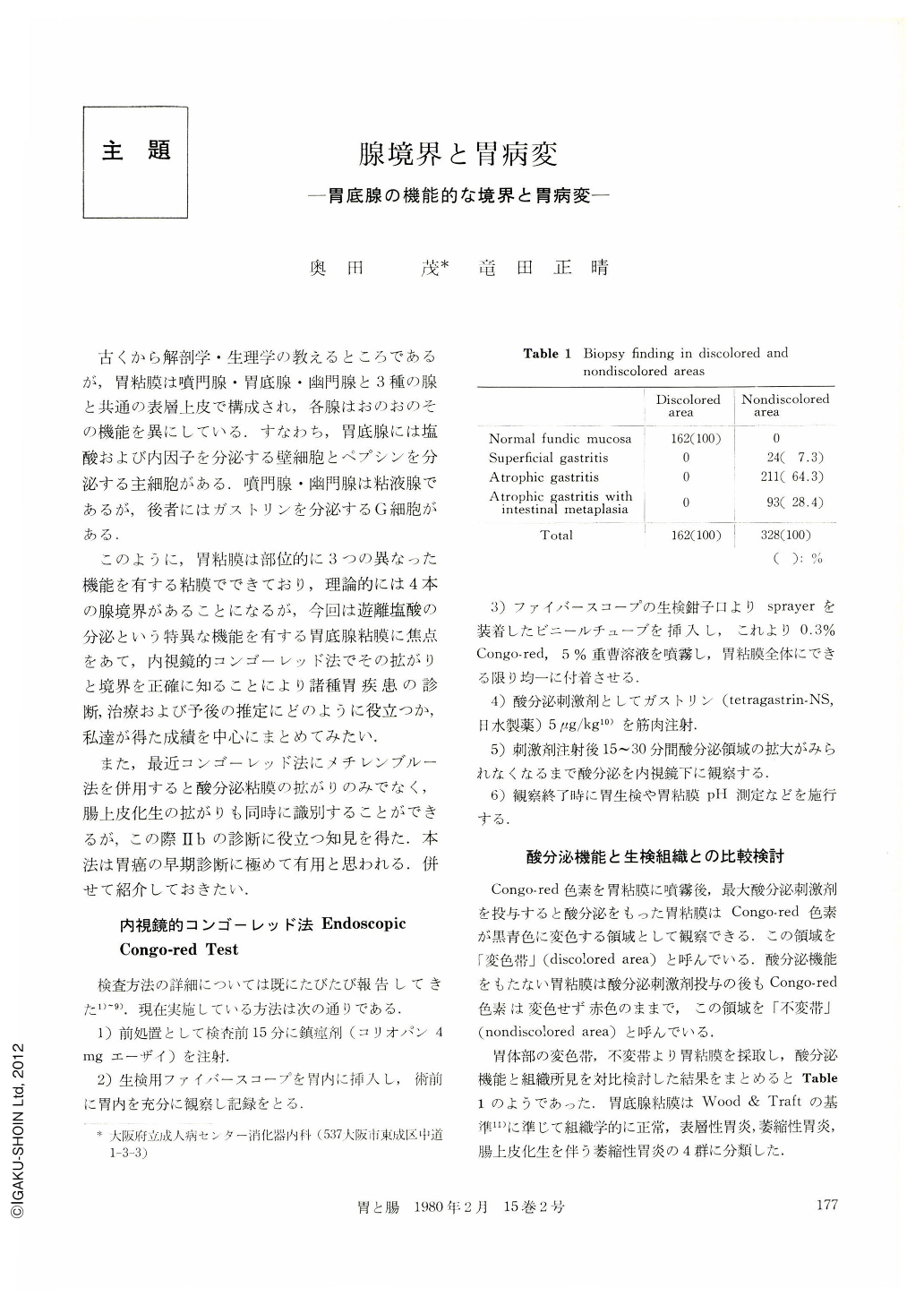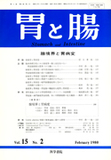Japanese
English
- 有料閲覧
- Abstract 文献概要
- 1ページ目 Look Inside
古くから解剖学・生理学の教えるところであるが,胃粘膜は噴門腺・胃底腺・幽門腺と3種の腺と共通の表層上皮で構成され,各腺はおのおのその機能を異にしている.すなわち,胃底腺には塩酸および内因子を分泌する壁細胞とペプシンを分泌する主細胞がある.噴門腺・幽門腺は粘液腺であるが,後者にはガストリンを分泌するG細胞がある.
このように,胃粘膜は部位的に3つの異なった機能を有する粘膜でできており,理論的には4本の腺境界があることになるが,今回は遊離塩酸の分泌という特異な機能を有する胃底腺粘膜に焦点をあて,内視鏡的コンゴーレッド法でその拡がりと境界を正確に知ることにより諸種胃疾患の診断,治療および予後の推定にどのように役立つか,私達が得た成績を中心にまとめてみたい.
The Congo red test was developed in our clinic for endoscopic observation of acid secretion. In this test, normal oxyntic gland area appears as a “discolored” area where Congo red becomes dark blue. The purpose of this study is 2-fold: to examine the relationship between acid-secreting border and histological glandular border, and to investigate various features of gastric lesions in relation to acid-secreting area.
1; Areas between histological funclic mucosa and acid-secreting area was extended with advancing years. We called these areas “areas of funclal gastritis”, because the main histological features of these areas were atrophic gastritis with and without intestinai metaplasia and severe superficial gastritis.
2; On the basis of acid-secreting function, we classified gastric ulcers into 3 types as follows; Type 1) those located in the acid-secreting area, Type 2) those located in nonacicl-secreting area and associated with 11 large acid-secreting area, and Type 3) those located in nonacid-secreting area, but associated with little or no acid-secreting area. Type 1 ulcer occured often in the angulus, and healing and repair was rapid endoscopically, and complete histologically. Type 2 ulcer located mainly in the angulus, adjacent to acidsecreting border. This type of ulcer did not heal well. Type 3 ulcer was found mainly in areas of fundal gastritis of the gastric body, far from acidsecreting mucosa. This type of ulcer healed faster, but recur more often. The pathogenesis of type 2 ulcer can be explained by Oi's dual control theory, but type 3 ulcer can not.
3; Gastric polyps were classified into 3 types. Type 1 polyp was located in the acid-secreting area. Moreover, the test revealed that gastric polyps had acidsecreting activity in 8 cases. The polyps were found only in the gastric body, and were not associated with fundal gastritis or intestinal metaplasia. Histologically they consisted of oxyntic gland with and Without a hamartomatous appearance. Gastric polyps located in the acitl-secreting area but without acidsecreting activity were mostly hyperplastic polyp; the exception was composed of pyloric gland with hamartomatous appearance. Type 2 polyp was located in the nonacid-secreting area and associated with a large acid-secreting area. Histologically verrucosa type was often seen, adjacent to acid-secreting area. Type 3 polyp was located in the nonacicl-secreting area and associated with little or no acid-secreting area. This type was mainly composed of hyperplastic polyp and ATP.
4; Gastric cancers were classified into 3 types on the basis of acid-secreting function. Type 1 cancer was located in acid-secreting area. The cancers were grossly ulcerated, and histologically undifferentiated. Type 2 cancer was located in the nonacid-secreting area, and associated with a large acid-secreting area. The cancers were grossly ulcerated in all cases, and histologically mainly undifferentiated. The extent of cancerous infiltration of type l and 2 cancer was easily determined by the Congo red test. Type 3 cancer was located in the nonacid-secreting area and associated with little or no acid-secreting area. The cancer were located far from acid-secreting area. The cancers were grossly ulcerated or polypoid, and histologically mainly differentiated. It was difficult to estimate the extent of this type cancer by the Congo red test, but Congo red test combined with methylene blue test makes it possible to determine the extent of the differentiated adenocarcinoma.

Copyright © 1980, Igaku-Shoin Ltd. All rights reserved.


